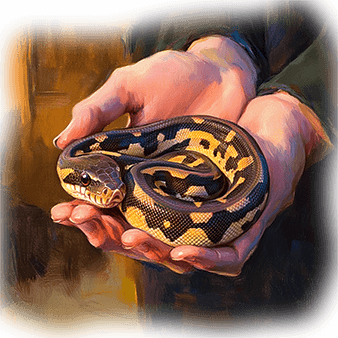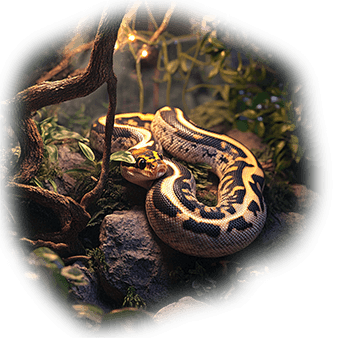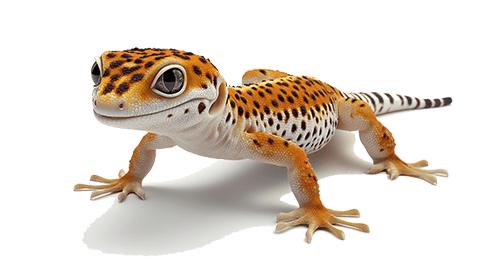Ball Pythons as Pets – Everything You Need to Know

If you’re looking for a calm, low-maintenance reptile, ball pythons might be your perfect match. These snakes are one of the most popular pet reptiles, and it’s no wonder—they have a docile nature, manageable size, and striking patterns. Plus, they’re quite fascinating creatures in their own right!
Sleeping Habits
Ball pythons are nocturnal – this means they are most active during the evening and night. Throughout the day, you’ll usually find them curled up in a hide or burrow. They don’t need a lot of stimulation, so don’t be alarmed if your ball python seems inactive for most of the time. They’re conserving energy, which is part of their nature. In the wild, they spend most of their day hiding to avoid predators, so providing a few secure hiding spots in their enclosure is essential.

Feeding Routine
When it comes to feeding, ball pythons prefer a steady diet of rodents – usually mice or small rats, depending on their size. These snakes are ambush predators, meaning they like to wait for their prey to come to them before striking. As pets, they’re typically fed pre-killed prey, which is safer for them and easier for owners to manage.
Younger ball pythons need to eat about once a week, while adult pythons may only need to eat once every 10 to 14 days. Overfeeding can lead to obesity, which can cause health issues, so it’s important to stick to a feeding schedule and avoid offering food too frequently. After eating, they often retreat to their hides to digest—this is totally normal.

Handling and Relationship with Humans
Ball pythons have earned a reputation as one of the most easy-going snakes to handle – their calm demeanor makes them great for beginners. They’re called “ball” pythons because when they feel threatened or stressed, they curl into a tight ball, tucking their head into the center. This defensive behavior is a far cry from aggressive, so with proper care and respect, they rarely bite.
If you’re looking for a pet that enjoys interaction, ball pythons might not seek out affection the way a dog or cat would, but they tolerate handling quite well. The more you handle your ball python (gently and with respect), the more they’ll become accustomed to you. It’s a good idea to handle them a few times a week, outside of their feeding days, to maintain a bond.

Activity Levels
These snakes are not overly active creatures – they’re slow-moving and prefer a sedentary lifestyle. However, they will explore their enclosure, especially in the evening when they’re feeling curious. This means you’ll want to set up an enriched environment with plenty of places to hide, climb, and explore. But don’t expect them to be slithering around all the time. Much of their time will be spent resting and conserving energy.

Habitat Preferences
Ball pythons thrive in environments that mimic their natural habitat – warm and humid. Their enclosure should have a temperature gradient, with a warm side around 88-92°F for basking and a cooler side around 78-80°F. They also need a humid environment, with humidity levels around 50-60%, as this helps with shedding and overall health.
Make sure their enclosure has secure, tight-fitting lids, as ball pythons are known to be escape artists. They love to hide, so providing plenty of hides, as well as branches or sturdy decor for climbing, is important for keeping them happy.

Interesting Facts About Ball Pythons
- Longevity – Ball pythons can live up to 30 years in captivity, and some have even been known to live longer! This makes them a long-term commitment, so it’s worth considering their lifespan before bringing one home.
- Size – These snakes stay fairly small compared to other python species. Most adults reach around 3 to 5 feet in length, which makes them manageable and ideal for pet ownership.
- Colors and Patterns – Ball pythons come in a variety of morphs (color and pattern variations). From the classic brown and black to stunning pastel and piebald morphs, the variety is endless and one of the reasons they’re so popular with hobbyists.
- Shedding Process – Like all reptiles, ball pythons shed their skin as they grow. Before shedding, their eyes turn a milky blue, and their color may dull. This is called “going into blue.” During this time, they might become more reclusive or irritable. Providing higher humidity during shedding helps ensure they can shed completely.

What They Like
Ball pythons love feeling secure – this means having dark, enclosed spaces where they can hide. They aren’t fans of open spaces, which can make them feel exposed. This is why it’s crucial to offer hides in their enclosure. They also enjoy warmth, which is why a heat lamp or under-tank heater is essential for their comfort.
If you’re into reptiles but don’t want a high-energy pet, ball pythons might be the perfect choice. Their calm, gentle nature and relatively low-maintenance care make them an ideal reptile companion, especially for first-time snake owners.

Final Thoughts
Ball pythons are peaceful, curious, and relatively low-maintenance pets. While they may not be as interactive as some other animals, their calm demeanor and unique behaviors make them fascinating companions. If you’re prepared to care for them properly, provide them with the right habitat, and stick to a feeding routine, you’ll find them to be incredibly rewarding pets. Just remember – patience and respect go a long way with these amazing snakes.
Further reading: “Ball Python Care: A Comprehensive Guide to Keeping Ball Python as Pets, Including It’s Diet, Handling Techniques, Feeding, Breeding, Habitats, Morps, Temperament And Cost” (Amazon affiliate link) by Goodman Roberts.
Affiliate Disclosure
This post may contain affiliate links, which means I earn from purchases made through links. Please see the privacy policy page for more details.






